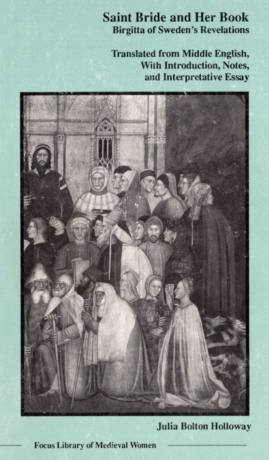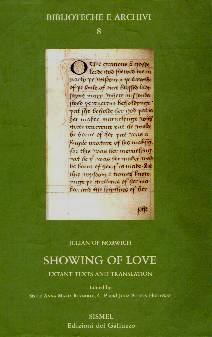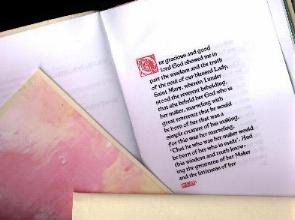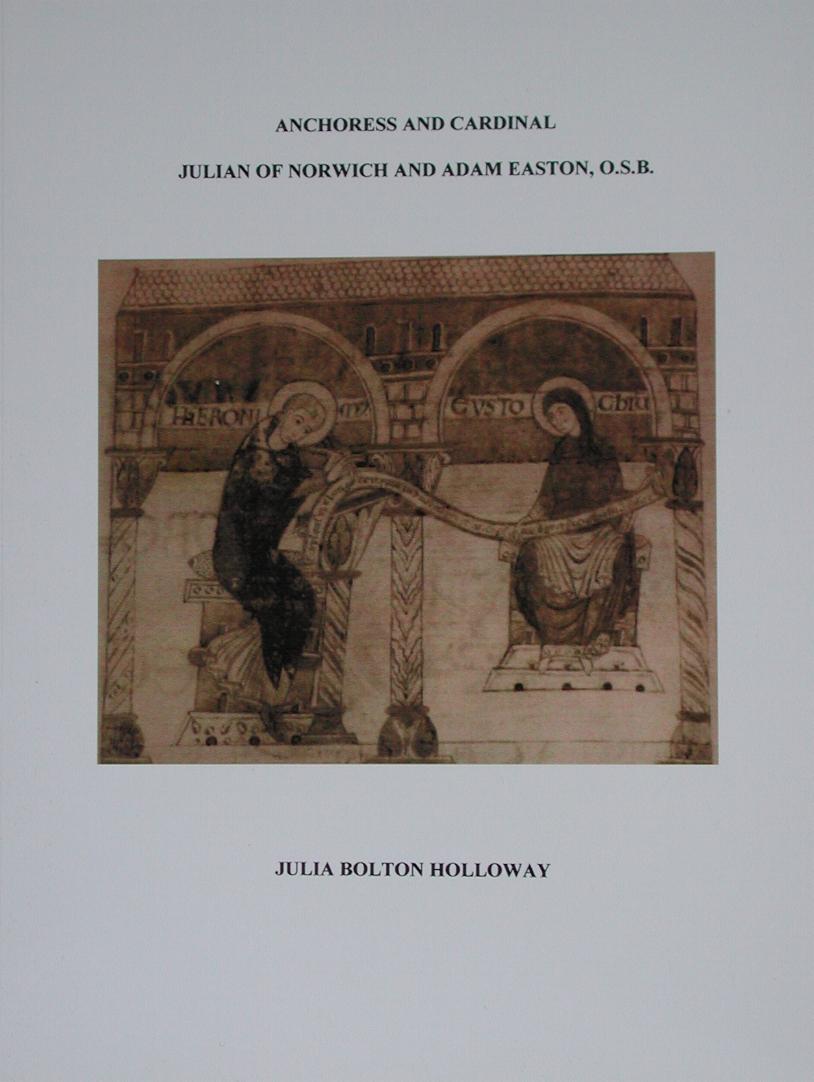
CARDINAL ADAM EASTON'S
LETTER TO VADSTENA'S ABBESS
EDITED, JAMES HOGG

Cardinal to right of Pope at Birgitta's right, may be Adam Easton. Lubeck; Ghotan, 1492 editio princeps engraving.
 HE manuscripts
containing Cardinal Adam Easton 's Defensorium
Sancte Birgittae/ For an account of Adam Easton see Leslie John
MacFarlane, 'The Life and Writings of Adam Easton, O.S.B.',
University of London, Thesis, 1955. The extant manuscripts
seem to be Oxford, Bodleian Library, Hamilton 2; Lincoln
Cathedral Chapter Library A.5.4 (114), now housed at
Nottingham University; Uppsala, University Library C518, C621,
MacFarlane also indicating C519. It was briefly discussed by
W.A. Pantin, 'The Defensorium of Adam Easton', English
Historical Review 51 (1936), 675-80, MacFarlane, pp.
217-34./ also offer a letter
that the Benedictine cardinal wrote to the Abbess and
community in Vadstena, presumably in 1390 to judge by the
incomplete indications in the Lincoln Cathedral Chapter A.5.4
(114) manuscript , 'Scriptum Rome ix die Februarii. Adam
Cardinalis Anglie' /The
manuscript was described in detail by R.M Woolley, Catalogue
of the Manuscripts of Lincoln Cathedral Library (Oxford,
1927), 80-82, and again with great expertise by R.M. Thomson,
Catalogue of the Manuscripts of Lincoln Cathedral Chapter
Library (Cambridge, 1989), 87-89. MacFarlane, 219-20,
also offers a description, but his folio indications are one
less than those given by Thomson. Dating from the fifteenth
century, written in a uniform hybrid hand, the manuscript
consists of 116 folios, numbered 1-115, the first folio not
being counted in the numbering. the first 11 (of 19) items
concern St Birgitta and are mainly conceived to defend the
authenticity of her revelations (see similar compilations in
Oxford, Bodleian Library, Bodley 346, and Balliol College
225). The Brigittine items are: 1. Selected Offices and
Prayers for the Blessed Virgin Mary, fols. 1-4v; 2. Prologus
Magistri Mathie in Librum Celestium Revelationum Beatee
Birgittae, fols. 5v-7v; 3. Alphonsus of Jaen, Epistola
Solitarii ad Reges, chapters 1-7, fols. 7v-17; 4. 'Incipit
epistola uenerabilis uiri fratris Magni Petri generalis
confessoris monasterii Watzentsteen contra calumpniantes
sanctissimas reuelaciones beate Birgitte de regno Swecie olim
diuinitus inspiratas. Ad laudem et honorem et gloriam . . .
Gratia domini nostri Ihesu Cristi sit cum omnibus uobis amen'
(fols. 17-18v); 5. 'Incipit epistola cuiusdam religiosi
ordinis fratrum minorum contra impugnantes sanctissimas
reuelaciones beate Birgitte de regno Swecie oriunde in Romam
et ecclesias inciperet reformare' (fols. 18v-24v); 6. Adam
Easton, Defensorium Beatae Birgittae (fols. 24v-49v); 7.
'Pater amantissime cum reuerencia et correctione uestre
altissime sapiencie et doctrine . . . Et protegat in aduersis
ipsa sapientia Dei patris Amen. Adam Cardinalis' (fols.
49v-50); 8. 'Epistola domini cardinalis Anglie ad abbatissam
et conuentum' (fols. 50-50v); 9. 'Sermo sanctissimi in Cristo
patris domini Bonifatii pape noni pro canonizacione beate
Brigitte habitus atque factus' (fols 50v-54v); 10. Vita Beatae
Birgittae (fols 54v-61v); 11. Offices for Bridget, Visitation,
Crown of Thorns (fols. 62-66)./From
the contents of the letter it is clear that it must predate St
Birgitta's canonization on 7 October 1391, though it cannot
have been written before 1390, as Easton was only restored to
his cardinalate in December 1389 following Pope Urban's
decease, after a lengthy period of imprisonment that began on
11 January 1385, when along with five other cardinals he was
thrust into duress on account of a supposed conspiracy against
the pontiff. Easton was more fortunate than his confreres, as
they apparently all perished in their confinement. Easton
attributed his survival to the intercession of Birgitta, whom
he earnestly hoped to see canonized. His Defensorium
refuted a Perugian Libellus against Birgitta's Revelationes.
Unfortunately, the Defensorium is not dated, but as it
is signed by Easton as Cardinal it is probably that it was
officially presented after his restoration to the purple in
Pope Boniface IX's consistory held on 18 December 1389, though
it may well have been compiled during his imprisonment.
HE manuscripts
containing Cardinal Adam Easton 's Defensorium
Sancte Birgittae/ For an account of Adam Easton see Leslie John
MacFarlane, 'The Life and Writings of Adam Easton, O.S.B.',
University of London, Thesis, 1955. The extant manuscripts
seem to be Oxford, Bodleian Library, Hamilton 2; Lincoln
Cathedral Chapter Library A.5.4 (114), now housed at
Nottingham University; Uppsala, University Library C518, C621,
MacFarlane also indicating C519. It was briefly discussed by
W.A. Pantin, 'The Defensorium of Adam Easton', English
Historical Review 51 (1936), 675-80, MacFarlane, pp.
217-34./ also offer a letter
that the Benedictine cardinal wrote to the Abbess and
community in Vadstena, presumably in 1390 to judge by the
incomplete indications in the Lincoln Cathedral Chapter A.5.4
(114) manuscript , 'Scriptum Rome ix die Februarii. Adam
Cardinalis Anglie' /The
manuscript was described in detail by R.M Woolley, Catalogue
of the Manuscripts of Lincoln Cathedral Library (Oxford,
1927), 80-82, and again with great expertise by R.M. Thomson,
Catalogue of the Manuscripts of Lincoln Cathedral Chapter
Library (Cambridge, 1989), 87-89. MacFarlane, 219-20,
also offers a description, but his folio indications are one
less than those given by Thomson. Dating from the fifteenth
century, written in a uniform hybrid hand, the manuscript
consists of 116 folios, numbered 1-115, the first folio not
being counted in the numbering. the first 11 (of 19) items
concern St Birgitta and are mainly conceived to defend the
authenticity of her revelations (see similar compilations in
Oxford, Bodleian Library, Bodley 346, and Balliol College
225). The Brigittine items are: 1. Selected Offices and
Prayers for the Blessed Virgin Mary, fols. 1-4v; 2. Prologus
Magistri Mathie in Librum Celestium Revelationum Beatee
Birgittae, fols. 5v-7v; 3. Alphonsus of Jaen, Epistola
Solitarii ad Reges, chapters 1-7, fols. 7v-17; 4. 'Incipit
epistola uenerabilis uiri fratris Magni Petri generalis
confessoris monasterii Watzentsteen contra calumpniantes
sanctissimas reuelaciones beate Birgitte de regno Swecie olim
diuinitus inspiratas. Ad laudem et honorem et gloriam . . .
Gratia domini nostri Ihesu Cristi sit cum omnibus uobis amen'
(fols. 17-18v); 5. 'Incipit epistola cuiusdam religiosi
ordinis fratrum minorum contra impugnantes sanctissimas
reuelaciones beate Birgitte de regno Swecie oriunde in Romam
et ecclesias inciperet reformare' (fols. 18v-24v); 6. Adam
Easton, Defensorium Beatae Birgittae (fols. 24v-49v); 7.
'Pater amantissime cum reuerencia et correctione uestre
altissime sapiencie et doctrine . . . Et protegat in aduersis
ipsa sapientia Dei patris Amen. Adam Cardinalis' (fols.
49v-50); 8. 'Epistola domini cardinalis Anglie ad abbatissam
et conuentum' (fols. 50-50v); 9. 'Sermo sanctissimi in Cristo
patris domini Bonifatii pape noni pro canonizacione beate
Brigitte habitus atque factus' (fols 50v-54v); 10. Vita Beatae
Birgittae (fols 54v-61v); 11. Offices for Bridget, Visitation,
Crown of Thorns (fols. 62-66)./From
the contents of the letter it is clear that it must predate St
Birgitta's canonization on 7 October 1391, though it cannot
have been written before 1390, as Easton was only restored to
his cardinalate in December 1389 following Pope Urban's
decease, after a lengthy period of imprisonment that began on
11 January 1385, when along with five other cardinals he was
thrust into duress on account of a supposed conspiracy against
the pontiff. Easton was more fortunate than his confreres, as
they apparently all perished in their confinement. Easton
attributed his survival to the intercession of Birgitta, whom
he earnestly hoped to see canonized. His Defensorium
refuted a Perugian Libellus against Birgitta's Revelationes.
Unfortunately, the Defensorium is not dated, but as it
is signed by Easton as Cardinal it is probably that it was
officially presented after his restoration to the purple in
Pope Boniface IX's consistory held on 18 December 1389, though
it may well have been compiled during his imprisonment.
Soon after the death of Birgitta in Rome on 23 July 1373 her cause for canonization was urged and as early as May 1376 Pope Gregory XI appointed a commission to consider the case at the request of the Holy Roman Emperor, the King, bishops, and nobility of Sweden/Isak Collijn, Acta et processus canonizacionis Beate Birgitte, Samlingar utgivna av Svenska Fornskriftsaliskapet, Andra Serien, Latinska Skrifter 1 (Uppsala 1924-31), 4./.
After Pope Gregory XI's death, Urban VI interested himself in the case, appointing in a consistory held on 15 December four cardinals/Thomas Frignano (Gradensis); John of Amelia (Corfiensis), Agapitus of Columpna, and Gentilis de Sangro: Collijn, Acta, 5; K. Eubel, Hierarchia Catholica Medii Aevi 1, Munster 1913, 23-24. Agapitus died in 1380 and Thomas Frignano in November, 1381./to examine the evidence collected to date and to scrutinize their orthodoxy. Probably in 1382 or 1383 three cardinals were delegated to assess the findings of this commission, John of Amelia, Lucas Radulfulco de Gentilis /Collijn, Acta , 600; Eubel, Hierarchia, I.23, lists Lucan Radulfulco (Nucerinus)/ and Adam Easton, who had been elevated to the purple in December 1381. The selection of Easton may have been due to the reputation he had gained for his recent Defensorium Ecclesiastice Potestatis / James Hogg writes 'There is no evidence that Easton encountered Birgitta in Rome and the fact that he makes no allusion to personal acquaintance with the saint is significant. On the other hand, he almost certainly met her daughter Katherine, as he gave evidence on 9 March 1379 along with her and Alphonso Pecha concerning the election of Urban VI according to Armarium LIV, vol 17, in the Vatican Archives./.
Though the form of Birgitta's revelations was certainly unusual, Easton as doctor of the Holy Scriptures, found the doctrine contained therein fully consonant with Catholic teaching and vigorously opposed the anonymous critic from Perugia/The Perugian cleric, termed 'Adversarius ', appears to have been the cause's Devil's Advocate, JBH/ , who launched a frontal attack on the Regula Salvatoris, which had been presented to Pope Urban V in Rome in October 1367 and approved, after some procrastination, in an emended form in 1370, receiving further confirmation from Gregory XI in 1375, before Urban VI formally approved the Brigittine Order and the rule in his bull of 3 December 1378. The Perugian sceptic clearly must have been a conservative cleric, who distrusted mysticism and was duly aggrieved to see a woman founding a religious order, particularly when she claimed to be following the immediate directives of Christ, God the Father, and the Blessed Virgin.
Unfortunately, the Perugian's Libellus has not been identified, which makes the dating of Easton's Defensorium hypothetical. It would, however, seem unlikely that he embarked on such a work before he was officially connected with Birgitta's cause and its composition may well be some years later, for Easton refers to his Defensorium in his letter to the Abbess and community of Vadstena, mentioning a copy sent to Alphonsus of Jaen, who had been assiduously promoting Birgitta's cause and who died on 19 August 1388. The Defensorium may have been conceived of as a thanksgiving for Birgitta's intercession for him in 1385, which Easton believed had preserved him from a worse fate than imprisonment. If this was the case, it would have been compiled 1385-88 and presented to Boniface IX after his restitution to the cardinalate in 1391, - Easton signs it as cardinal, - but before Birgitta's canonization in 1391. The prologue to the Defensorium, addressed to Boniface IX, may well have been written after the text was terminated, for it summarizes the Perugian theologian's objections to Birgitta's writings, particularly the Regula Salvatoris and the Sermo Angelicus, that Easton was to refute in his 41 articles.
Easton, with considerable breadth of vision for his time, repudiates the Perugian's view that neither Christ nor even an angel would have deigned to appear to a woman and dictate a rule, urging that the risen Christ first showed Himself to a woman after the Resurrection (Matthew 28) and that angels frequently appeared to the prophets. that Birgitta was a prophetess could hardly be disputed in Easton's opinion, as she had foreseen the Great Schism in Revelationes VI.63 . Her deep spirituality, her virtues, and the mortified life she led, - here Easton cites Romans VIII, - ruled out a Satanic or halucinatory origin for her revelation/ Bodleian Library Hamilton 7, art. 1-2, folios 229-31. All references are to this manuscript, which was collated with Lincoln Cathedral Chapter Library 114 (referred to in the notes as L in the following transcript). The Bodleian manuscripts is briefly described in Falconer Maden, A Summary Catalogue of Western Manuscripts in the Bodleian Library V (Oxford, 1905), 14-15, and in more detail in MacFarlane, 218. A paper manuscript of the fifteenth century, which came to be at Erfurt, but was likely written at Vadstena, contains 1. Bulla canonizationis beate Birgitte de regno Swecie (fol. 1); 2. Incipit primus liver revelationum celestium domine Birgitte (fol. 30); 3. Incipit defensorium S. Birgitta (fol. 229); 4. Peticio admissionis articulorum (fol. 248), 5, Epistola Adam cardinalis (fol. 248)./.
The Perugian objected to the inelegant Latin of the texts, unworthy of divine origin, which led to a reluctance on the part of the Holy See to approve the Regula Salvatoris. Easton retaliates by citing St Paul's advice to the Hebrews and the Corinthians/ Hebrews 5.12-14; 2 Corinthians 10./. Furthermore, the Rule of St Pachomius can hardly be regarded as a model of elegance, but it received papal approval, as did the Regula Salvatoris under Gregory XI and Urban VI / Defensorium, article 7, fol. 231v./.
The Perugian also attacked the theology of the Regula Salvatoris, apparently claiming that it stated that God the Father was incarnate by the Virgin Mary, a misreading that Easton repudiates / Defensorium, articles 5-6, fols. 231v./.
Interestingly, Easton cautiously promotes feministic theological positions in the late fourteenth century, for he pours scorn on the Perugian's assertion that women could never be allowed to compile a rule, as they were prohibited from preaching and exercising public ecclesiastical functions by Holy Writ, referring the Perugian to St Thomas Aquinas' Summa Theologiae Ia. q. 54, art. 1, where the Dominican concedes the right to women to engage in such activities in private which was, according to him, Birgitta's case/ Defensorium, article 7, fol. 231v./. Easton then lists a number of examples showing women receiving special revelations from God.
After having disposed of the Perugian's specific charges, Easton devotes the bulk of his work to a study of the Regula Salvatoris , the Sermo Angelicus , and Birgitta's Orationes , showing in his analyses, that he had a good knowledge of the Rule of St Augustine, and those of St Benedict, St Dominic, and St Francis of Assisi, stressing that, as the Regula Salvatoris was intended for both men and women, it was bound to differ in spirit from purely masculine prescriptions and that the approbation of the Holy See was in itself sufficient guarantee of its orthodoxy. Objections to the Brigittine habit were dismissed as trivial/ Defensorium , articles 8-10, fol. 233-233v./.
Easton's remaining 31 aricles seek to justify the Brigittine liturgy as contained in the Sermo Angelicus, an office specifically centred on the Blessed Virgin, but which, as Easton points out, contains in its readings a complete, if brief, outline of the whole of Christian historical theology as food for meditation in an enclosed order.
Though Easton is certainly eloquent in his Defensorium, the Perugian's discussion of the problem of evil arising from the free-will of the angels, the then still disputed question of the Immaculate Conception of the Blessed Virgin, and the role of her suffering in the divine plan of the Redemption were questions that occupied the best theological minds for several centuries to come, whilst her bodily assumption into heaven after her decease was only defined as a dogma in 1950. Many present-day biblical scholars would share the Perugian's distaste for the apocrypha's misguided contributions to an exaggerated Mariology. Easton seeks to refute the Perugian point by point, insisting on the magnitude of the angels' sin by misusing their freedom, citing in support St Augustine (De Genesim 4 and De Civitate 3,9,11,12,13 and 15), St Anselm of Canterbury, St Thomas Aquinas (Summa Theologiae Ia. q. 61, art 6), Aristotle, St John of Damascus, and the text of Holy Scripture. In favour of the Immaculate Conception, he quotes the Tractatus de Conceptione Beatae Virginis Mariae of Peter Aureola, along with the assertions of St Augustine in the De Predestinatione Sanctorum and De Trinitate, as well as St Thomas Aquinas' declaration in Summa Theologiae IIIa, q. 2, art. 11. He expatiates at length on the sufferings of the Blessed Virgin, utilising all the biblical sources together with Bede's commentary on St Luke, concluding that her assumption and coronation in heaven were previsaged by Denis the Areopagite, St Augustine, Boethius, St Thomas Aquinas, Nicholas of Lyra, and even the Hebrew glosses to the biblical texts. His concluding article depicts his own deep devotion to the Blessed Virgin.
Easton's Defensorium is a real tour de
force, whereby he successfully demonstrated that the
assertions of the Revelationes are confirmed by the
teachings of the Doctors of the Church at virtually every
point/ Defensorium ,
article 23, fol. 239./.
pistola domini cardinalis ad abatissam et
conventum
arissime domine et sorores, ad devocioenm
devotissime domine Brigitte vos exhortor, quoniam nuper
tempore Urbani olim pape vi in tribulacione magna positus
fueram sine causa, et eius furorem senciens et periculum
grande nimis, quod mortem evadere non speravi sine canctorum
miraculo et sanctarum; inter alias sanctas veni ad devotam
Brigittam antedictam et ipsa intercederet pro me liberaret,
et ad eius canonizacionem ponerem diligenciam meam totam, et
hoc continuatis vicibus diu feci. In tantum quod eius
adiutorio singulari et meritis eius sanctis spero me fuisse
a furoribus predictis tirannicis liberatum. In diversis
eciam aliis tribulacionibus fuerma circumseptus, et eius
adiutorium supplicavi, et semper inveni remedium
singulariter, in tantum quod in tormentis positus,
tirannorum nullatenus penam sensi. Quapropter iuxta votum
meum predicum vos omnes sollicito quantum possum ut ad eius
canonizacionem laborare dignemini cum effectu cum vestris ut
suis consanguineis et amicis. Ante omnia tamen vos moveo in
visceribus caritatis, ut omni die ad beatam virginem Mariam
dignemini porrigere preces vestras, quod ipsa inspiret
consilium et auxilium in hac parte. De aliquibus vero emulis
suis nitentibus canonizacionem suam et obliquia impedire,
non modo moveamini nec perturbacionem aliquam habeatis. Nam
vidi quendam libellum in Perusio compositum per articulos
contra regulam suam sancta. Et videbatur michi quod libellus
fuit valde difficilis ad solvendum, sed ad ipsam dominam
Brigittam perrepi continue preces meas intercedens, quod
ipsa pro me apud beatam virginem exoraret, ut in
declaracione et dubiis factis contra eam iuxta veritatem
scripture sacre lucide me informare et ab imminentibus
periculis liberaret. Et statim perlegi libellum compositum
contra eam, et videbatur michi quod habui solucionem et
veritatem omnium dubiorum; et quanto magis legi, tanto
fueram clarius super tota materis informatus; et libellu,
contrarium composui iuxta notata per sacrarum testimonis
scripturarum et doctores alios approbatos, et incipit iste
liber: Respondebo
exprobantibus michi verbum. Et illum libellum per articulos declaratos
transmisi domino Alphonso eius devoto ad Ianuam isto anno.
Unde me reputo securum quod si laboraveritis cum devocione
debite ad premissa, intentum habebits Deo duce. Nunquam enim
michi defecerat quando ipsam debite invocavi. Recommendo me
vestris oracionibus penes eam, ut ipsa pro me interpellet
apud Deum, quod preseevet a periculis vitam meam et digigat
ad salutem; quorum amiciciam diu consevet in prosperis
omnipotens ipse Deus precibus devote Brigitte sacrosanctis
DEFENSORIUM SANCTE BIRGITTA
Respondebo exprobantibus michi verbum. Ps. CXVIII.
eatissime pater, cum verbo domini celi firmati
sunt, et spiritu oris eius omnis virtus eorum'. Psalmus
[XXXXII]. Ego A[dam] etc., servitor humilis vestre
beatissime sanctitatis et devotus illustris domine, domine
Brigitte, confidens in virtute et sapiencia huius verbi quod
'in principio erat Verbum, et Verbum erat apud Deum, et Deus
erat Verbum'. et tandem pro reparacione humani generis et
salute, hoc 'Verbum caro factum est, et habitavit in nobis,
plenum gracie et veritatis' Iohannis primo. Ac claro intuitu
mentis cernes exprobantes predictam dominam verbo suo penes
sanctissimum dominum predecessorem vestre beatitudinis et
vestram eciam sanctitatem, ne vita eius sut dicta, seu
pocius verbum Dei in aliquo approbentur, de quibus ipsa
domina conqueritur per psalmistam: 'Verbum iniquum
constituerunt adversum me. Numquid qui dormit non addiciate
ut resurgat?' Ne tanta lux veritatis sub modio exprobantibus
et oblequentis, a facie inimici et persequentis, in persona
domine antedicte ad calumpniancium, vituperium et horrorem:
'Respondebo exprobantibus michi verbum'.
Primo enim exprobatur domina antedicta super contentis in prologo regule suarum monialium devotarum.
Secundo super grosso et rudi stil et ita defectuoso regule antedicte quod sine supplecione non deberet a sede apostolica approbari.
Tercio exprobat regulam domine prius dicte, quia ponit, ut adversarius male capit, patrem in divinis esse de corpore Virginis incarnatum.
Quarto obicit de regula prius dicta quod Christus non dictavit eam proprio ore suop, nec per mulierem eciam fecerat eam publicari, et sic vadit per lecciones et oraciones plurima combinando et magnam partem per articulos deprevando.
Sed 'quia rectum est verbum domini, et [omnia] opera eius in fide.' in Ps., cum Christi et beate Virginis adiutirio, qui istam dominam in isto et aliis negociis informarunt, nam ipsa continue sic oravit: 'Humiliatus sum usquequaque, domine; vivifica me secundum verbum tuum,' cum istis obieccionibus 'respondebo exprobantibus michi verbum'. Nam 'lucerna pedibus meis verbum tuum, et lumen semitis meis,' ut in eorum impugnacionibus non deficiat verbum meum contra malignantis versuscias cautelosas in pluribus et verbales, qui magis deberent in verborum sentenciam imputare. 'Memor esto verbi tui in quo michi spem dedisti', 'et ne auferas de ore meo verbum veritatis usquequaque'. 'Et respondebo exprobantibus michi verbum', quod michi concedat dominus Ihesus Christus meritis Virginis gloriose et devote Brigitte famule matris Dei, pro cuius honore incepi presens opusculum compilatum, ut respondeam exprobantibus michi verbum, submittendo me correcionibus omnium, uet est in tractatibus consuetum.
[Articles 1-41 follow]
Peticio admissionis articulorum [fol. 248]
 ater beatissime, cum
reverencia semper et coreccione vestre altissime sapiencie
et doctrine omnes predictos articulos per iudicium
sufficienti diligencia et vigilancia sicut iacent reputo eos
admittendos, publicandos et legendos in ecclesia sancta Dei,
quoniam sicut iacent sunt veri et catholici et proposiciones
fidei vel sequentes ex fide, vel ex veritate scripture
sancta consona et bonis moribus concordantes, ut ex doctrina
philosophorum, sanctorum et sapiencium hominum et doctorum.
Nec dicti articuli loquuntur inepte sicut adversaius
asseruit et confingit, sed loquuntur iuxta modum loquendi
scripture sacre et sanctorum doctorum maxime antiquorum;
quare evidenter apparet quod erant a Deo specialiter
revelati. Et sic non sunt huiusmodi articuli materia
heresis, sed materia fidei et devocionis et bonorum morum et
operum inductivi, et ad exaltacionem sancte matris ecclesie
introducti, quam conservet semper in prosperis et protegat
in adversis ipsa sapiencia Dei patris. Amen.
ater beatissime, cum
reverencia semper et coreccione vestre altissime sapiencie
et doctrine omnes predictos articulos per iudicium
sufficienti diligencia et vigilancia sicut iacent reputo eos
admittendos, publicandos et legendos in ecclesia sancta Dei,
quoniam sicut iacent sunt veri et catholici et proposiciones
fidei vel sequentes ex fide, vel ex veritate scripture
sancta consona et bonis moribus concordantes, ut ex doctrina
philosophorum, sanctorum et sapiencium hominum et doctorum.
Nec dicti articuli loquuntur inepte sicut adversaius
asseruit et confingit, sed loquuntur iuxta modum loquendi
scripture sacre et sanctorum doctorum maxime antiquorum;
quare evidenter apparet quod erant a Deo specialiter
revelati. Et sic non sunt huiusmodi articuli materia
heresis, sed materia fidei et devocionis et bonorum morum et
operum inductivi, et ad exaltacionem sancte matris ecclesie
introducti, quam conservet semper in prosperis et protegat
in adversis ipsa sapiencia Dei patris. Amen.
Consult also the excellent essay, James
Hogg, 'Adam Easton's Defensorium Sanctae Birgittae', The
Medieval Mystical Tradition, Volume 6, ed. Marion
Glasscoe (Woodbridge, Suffolk: Boydell and Brewer, 1999), pp.
213-240, and its copious citations. James Hogg does not
discuss the probable relationship between the Benedictine
Cardinal Adam Easton, of Norwich Cathedral Priory of the Most
Holy and Undivided Trinity, and the coeval Anchoress of
Benedictine St Julian's Church, Conisford, Norwich, Dame
Julian of Norwich, who likewise used the Hebrew Scriptures,
the Greek Testament, Pseudo-Dionysius, Augustine, John of
Salisbury, Birgitta of Sweden, and John Wyclif, in writing the
Showing of Love in Middle English. That relstionship
became the subject of two of my books, one of which he
published:
Indices
to Umiltà Website's Julian Essays:
Preface
Influences
on Julian
Her Self
Her
Contemporaries
Her Manuscipt
Texts ♫
with recorded readings of them
About Her
Manuscript Texts
After Julian,
Her Editors
Julian in our
Day
Publications related to Julian:


Saint Bride and Her Book: Birgitta of Sweden's Revelations Translated from Latin and Middle English with Introduction, Notes and Interpretative Essay. Focus Library of Medieval Women. Series Editor, Jane Chance. xv + 164 pp. Revised, republished, Boydell and Brewer, 1997. Republished, Boydell and Brewer, 2000. ISBN 0-941051-18-8
 To see an example of a
page inside with parallel text in Middle English and Modern
English, variants and explanatory notes, click here. Index to this book at http://www.umilta.net/julsismelindex.html
To see an example of a
page inside with parallel text in Middle English and Modern
English, variants and explanatory notes, click here. Index to this book at http://www.umilta.net/julsismelindex.html
Julian of
Norwich. Showing of Love: Extant Texts and Translation. Edited.
Sister Anna Maria Reynolds, C.P. and Julia Bolton Holloway.
Florence: SISMEL Edizioni del Galluzzo (Click
on British flag, enter 'Julian of Norwich' in search
box), 2001. Biblioteche e Archivi
8. XIV + 848 pp. ISBN 88-8450-095-8.
 To see inside this book, where God's words are
in red, Julian's in black, her
editor's in grey, click here.
To see inside this book, where God's words are
in red, Julian's in black, her
editor's in grey, click here.
Julian of
Norwich. Showing of Love. Translated, Julia Bolton
Holloway. Collegeville:
Liturgical Press;
London; Darton, Longman and Todd, 2003. Amazon
ISBN 0-8146-5169-0/ ISBN 023252503X. xxxiv + 133 pp. Index.
 To view sample copies, actual
size, click here.
To view sample copies, actual
size, click here.

'Colections'
by an English Nun in Exile: Bibliothèque Mazarine 1202.
Ed. Julia Bolton Holloway, Hermit of the Holy Family. Analecta
Cartusiana 119:26. Eds. James Hogg, Alain Girard, Daniel Le
Blévec. Salzburg: Institut für Anglistik und Amerikanistik
Universität Salzburg, 2006.

Anchoress and Cardinal: Julian of
Norwich and Adam Easton OSB. Analecta Cartusiana 35:20 Spiritualität
Heute und Gestern. Salzburg: Institut für Anglistik und
Amerikanistik Universität Salzburg, 2008. ISBN
978-3-902649-01-0. ix + 399 pp. Index. Plates.
Teresa Morris. Julian of Norwich: A
Comprehensive Bibliography and Handbook. Preface,
Julia Bolton Holloway. Lewiston: Edwin Mellen Press, 2010.
x + 310 pp. ISBN-13: 978-0-7734-3678-7; ISBN-10:
0-7734-3678-2. Maps. Index.

Fr Brendan
Pelphrey. Lo, How I Love Thee: Divine Love in Julian
of Norwich. Ed. Julia Bolton Holloway. Amazon,
2013. ISBN 978-1470198299

Julian among
the Books: Julian of Norwich's Theological Library.
Newcastle upon Tyne: Cambridge
Scholars Publishing, 2016. xxi + 328 pp. VII Plates, 59
Figures. ISBN (10): 1-4438-8894-X, ISBN (13)
978-1-4438-8894-3.

Mary's Dowry; An Anthology of Pilgrim and Contemplative Writings/ La Dote di Maria:Antologie di Testi di Pellegrine e Contemplativi. Traduzione di Gabriella Del Lungo Camiciotto. Testo a fronte, inglese/italiano. Analecta Cartusiana 35:21 Spiritualität Heute und Gestern. Salzburg: Institut für Anglistik und Amerikanistik Universität Salzburg, 2017. ISBN 978-3-903185-07-4. ix + 484 pp.
